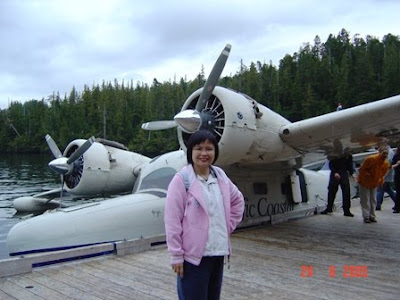From wherever you are, charter a flight to Vancouver. From Vancouver, you will be transferred to Bella Bella by another charter flight which is part of the luxury all inclusive package offered by King Pacific Lodge. From Bella Bella, you will be transferred to this remote resort by float plane. This is actually one of the top luxury resorts I have visited and at the same time, the most remote. I remember my boss said ‘We are in the middle of nowhere’ when we landed in Bella Bella. I’m sure you’ll feel the same when you are here.
Float plane in motion
I went there out of a corporate retreat. After a brief stop in Vancouver, we all went on our private chartered jet and flew over to King Pacific Lodge, the eco adventure luxury resort.
There are several reasons King Pacific Lodge is on my Top 10 List. Here are a few of them:
Best Whale Watching
There were only 17 rooms. Some of them had sea view and only two of them had a balcony. I was so lucky to have one with both sea view and a balcony. Hence I could enjoy whale watching by lying on a chair in my balcony. Three steps in whale watching: heard a sound, saw a splash of water, saw the whale’s head or tail or body. I went by late September and there were lots of them, as it was the best time in a year to watch whales at King Pacific Lodge.
Best Eco Adventure
Kayaking among sea lions and starfishes was something extremely interesting. The sea lions were curious to find out who we were and were not afraid of swimming around us. Water here was crystal clear and along the shore, we could see a lot of dark red starfishes, some of them had five limbs and some had more. Of course we did whale watching at near distance. I failed in bear watching because I went on a rainy day when the bears might probably prefer to stay home. Many other wildlife were seen in areas around the lodge.
 Best Luxury Hideaway Resort
Best Luxury Hideaway ResortKing Pacific Lodge is a perfect remote resort to do any corporate offsites because laptops and mobile phones wouldn’t work here. We were completely separated from rest of the world. My boss was happy to have full attention from everyone as they could not talk on mobile phones or check blackberries under the table while attending meetings. Likewise, if you want to enjoy a hideaway holiday, King Pacific Lodge is one of the top Canadian resorts where you won’t be disturbed by phone calls or emails.
Whale watching at the resort lobby

From their official website:
King Pacific Lodge provides the ultimate in luxury adventure travel and ecotourism vacations from its location in the heart of the Great Bear Rainforest on the west coast of British Columbia, Canada. As a luxury wilderness lodge, this is an unsurpassed eco adventure travel destination. Among its many accolades, King Pacific Lodge was selected as the Best Resort in Canada by Condé Nast Readers' Choice Awards in 2008 and again in 2009.– I personally think that KPL well deserves these awards.
Best of Private Jet Charter - Vacation Resort







